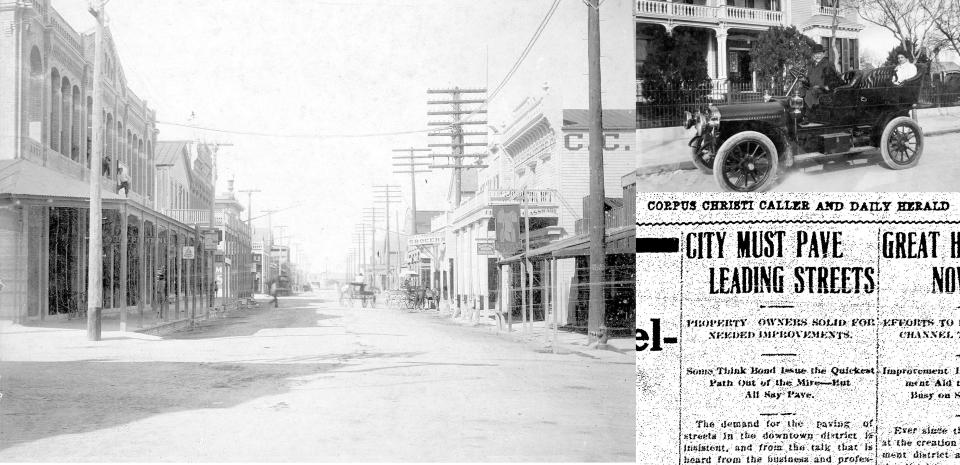#TBT: Corpus Christi paved its first streets in 1910s
Some certainties in life: death, taxes and people hate the condition of the streets in the city where they live.
"The effect of the recent heavy rains (has) demonstrated to many an unfortunate pedestrian that, although we have reason to be thankful to the clerk of the weather, we have a good right to complain of the miserable condition of our public highways. What are the mayor and aldermen so engaged in that they cannot find time to make such improvements as our people demand? It seems to us that when public officials are insufficient and slack, it is high time to remind them of their shortcomings."

It's not a stretch to imagine I could have read that paragraph in a letter to the editor submitted a month ago. But the actual publication date was Aug. 25, 1860, from the weekly newspaper in Corpus Christi, the Ranchero.
More: #TBT: Maverick Markets were South Texas staple for 40 years
The late historian and Caller-Times columnist Murphy Givens devoted a column to the condition of the early streets of the city in 2010, and the column contains a treasure trove of quotes from earlier newspapers about the hideous state of the streets over the decades.
Dirt roads that turned into mud with the slightest rain were the norm. The end of the Civil War brought some of the worst conditions, what with no city government in operation and the county government relocated to Santa Margarita. Dead animals also littered the streets, making for a noxious combination. The area's chief justice, John Dix — the equivalent of today's county judge — divided the county into precincts and designated all able-bodied male residents in each precinct as "road hands." I guess we can be glad we won't be conscripted into road repair work these days?
Through the late 19th and early 20th centuries, the roads were updated with shell and then gravel, but residents and business owners wanted paved streets. Grocery store operator A.R. Yeargen said when she arrived in 1911 the only paved street was a two-block section of Chaparral. "The other streets were mud. From our store, I could see horses bogging down in mud when it rained."
Voters approved a $150,000 bond to pave streets in late 1912, but taxpayers didn't shoulder the entire cost for paving. Property owners fronting the streets set for paving paid three-fourths of the cost and the city one-fourth.
And it must be a universal human trait to quibble over the correct material to pave a street.
"Street paving is the uppermost topic in Corpus Christi. On every street corner, in every office and home, conversation deals mostly with vitrified brick, wood block and bitulithic," stated the Aug. 11, 1912, Caller.
More: #TBT: In 1980s, the Tex-Mex Express train took passengers from Corpus Christi to Laredo
Many inches of the Caller-Times were dedicated to opinions on the best material to pave the roads, with everyone from ordinary citizens to retired street commissioners chiming in. The city even solicited opinions from other cities around the country, and the Caller published an entire page of recommendations from mayors and clerks sharing their method of paying for the paving and their preferred materials. Responses came from all over, including Dallas; Vicksburg, Mississippi; Montgomery, Alabama; Rochester, New York; and Sheboygan, Wisconsin. Readers loved the variety, and the Caller continued to publish more opinions over the next several months as more cities wrote in.
In 1913, more streets were ready for paving and the city added Belden, Twigg, Taylor, Mann, Lawrence, Schatzell, Peoples, William, Aubrey, Laguna and Upper Broadway to the paving list, with plans to finish the rest of Chaparral, Mesquite and Water. Thirteen years later, most of downtown was finally paved. And as the city grew, the street paving tried to keep up.
I, for one, reported some potholes in my neighborhood via the city's app in September. I noticed someone circled them with orange spray paint at the beginning of January so, progress, I guess? But while we lament the state of the streets, at least we can be grateful the streets aren't paved with literal mud and dead animal carcasses.
Allison Ehrlich writes about things to do in South Texas and has a weekly Throwback Thursday column on local history. Support local coverage like this by checking out our subscription options and special offers at Caller.com/subscribe
This article originally appeared on Corpus Christi Caller Times: Corpus Christi paved its first streets in 1910s

